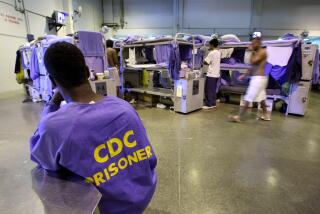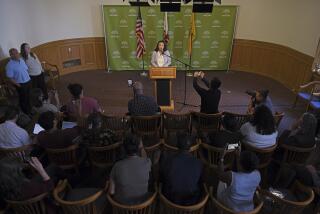Budget Earmarks Funds for Youths in Bid to Reduce Juvenile Crime
- Share via
OXNARD — Signaling a desire to curb deadly juvenile crime by expanding prevention rather than enforcement, the city’s latest spending plan proposes more money for youth programs but no increases for police.
Oxnard’s $60.5-million draft budget, released Wednesday, calls for funneling an extra $300,000 to recreation and youth programs for the fiscal year 1996-97.
As part of the plan, city officials would require youth programs to obtain matching grants from local businesses and organizations. The total could pay for 10 more after-school programs, a city-sponsored job corps and other projects.
“We feel that by helping youth . . . in our community, we are going to be helping our public safety programs,” said Grace Magistrale Hoffman, Oxnard’s management and budget officer.
While police and fire departments get no increase, the spending plan offers to spare them from a cut of up to 3.1% that all other city departments face because of a $1.3-million revenue shortfall.
But unlike other recent years, when budget deficits have spurred difficult cuts in Oxnard’s library services, recreation programs and other areas, city officials have notified department heads that they cannot scale back any public services. So to close the gap, department chiefs will have to find new sources of money or make their operations more efficient, officials said.
“In the past, the tactic was to cut services,” City Councilman Tom Holden said. “That is not the philosophy of the current council. We feel we can provide the same level of service with less money.”
Oxnard’s proposed 1996-97 spending plan is actually about $200,000 higher than last year’s budget of $60.3 million, but the slight increase does not account for inflation.
More than half--about $30.1 million--of the city’s proposed operating budget is earmarked for public safety, including police and fire. Another 15% of the budget would go toward such residents’ services as parks and libraries, about 10% toward administration and about 6% for community development.
Because the City Council has consistently ranked public safety as its top budget priority, Hoffman said, it was tough for officials not to boost the police and fire department budgets.
“The problem is that the city finds itself in a position that it doesn’t have a whole lot of money to grant [additional requests],” she said.
As police try to counter a recent wave of gang-related slayings, Police Chief Harold Hurtt said a lack of sustained funding for an anti-gang task force could strain the force’s resources.
“It means we will not be able to keep the level of funding that we have directed now toward gangs,” Hurtt said. “What we are going to try to do is stretch it as far as we possibly can.”
Michael Henderson, superintendent of Oxnard’s parks, said his department may also end up stretching available general fund money. Unlike the Police Department, Henderson must contend with the 3.1% reduction that may leave him with up to $80,000 less spending power next year.
On top of that, the proposed budget does not include the $300,000 Henderson had requested to reopen park restrooms seven days a week. Services were drastically scaled back in 1991.
“My assumption would be they would stay closed unless there are some other funding sources that could be found,” he said. “I don’t know what that would be.”
Budget officials plan to hold the first public hearing on the proposed spending plan at 1:30 p.m. June 4 in the City Council Chambers. If the budget process remains on schedule, Hoffman said city leaders could adopt the plan June 18.
Although the budget proposal does not call for laying off any employees, it does propose cutting eight positions citywide through attrition and restructuring.
“We are trying to make operations more efficient,” said Bruce Dandy, Oxnard’s personnel manager. “We will try and reposition the employees to avoid layoffs.”
More to Read
Sign up for Essential California
The most important California stories and recommendations in your inbox every morning.
You may occasionally receive promotional content from the Los Angeles Times.










